An argus keeper's tricks
Probably the four most important things when caring for a monitor are
caging, substrate, temperature, and food. If you can provide these, you'll probably
do fine keeping a monitor.
As far as caging goes, you've got to realize
that not only are monitors large animals, they are also quite active. They
need enclosures large enough to accomadate their active natures. In my
opinion, the minimum sized cage for a small female argus monitor would be
about 1 meter by 2 meters. A whole room would be better.
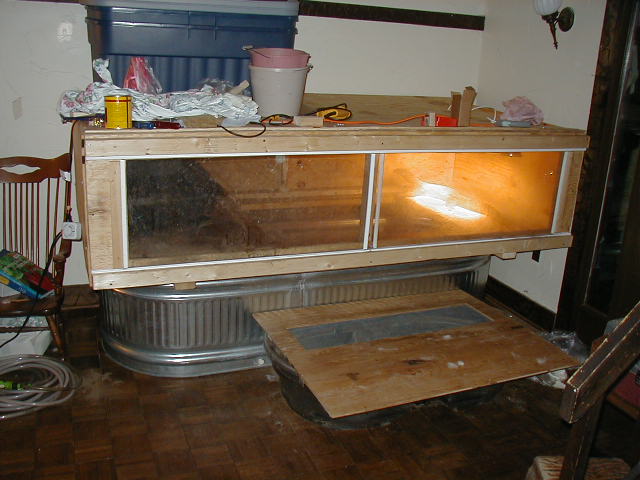
Caging for an adult male argus monitor.
These cages are made with a base consisting of an entire 8' x 4' sheet of plywood resting on a large galvanized steel stock tank. The stock tank holds dirt to burrow in. This enclosure could also hold a mating pair of arguses or other mid-sized monitors.
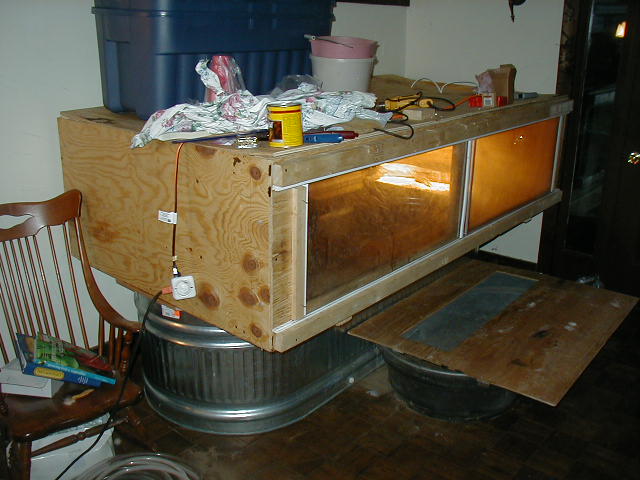
Another view of the same cage.
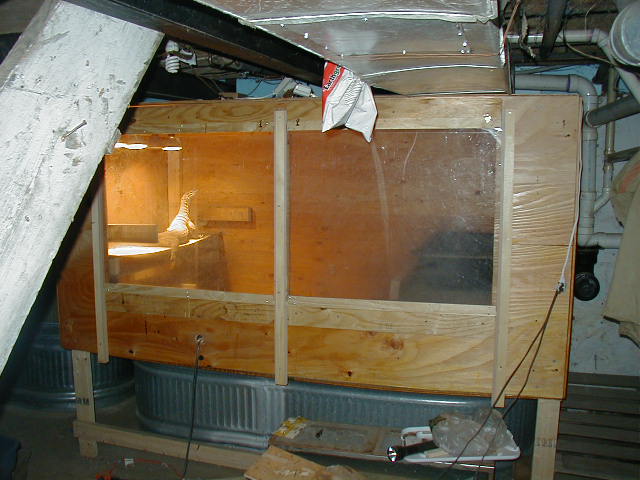
A different cage, this time taller.
The cage should have a place to hide. The hiding spot should be small enough
that it feels tight to the monitor. The monitor should be able to feel
the hide box pressing up against its back and belly. This helps them to feel
secure. A cardboard box with a hole cut in it does not really work, it is
usually to spaceous. A piece of plywood with 2x4s screwed into the bottom to
support it a small distance above the ground is readily accepted by larger
monitors. For smaller monitors, replace the 2x4s with thinner pieces of
wood, or just lay a sheel of wood on top of a loose substrate so the monitor
can make its own burrows under the wood. Cork rounds also work well if they are about the diameter of the monitor, they seem to emulate the hollow logs that can be found in the wild.
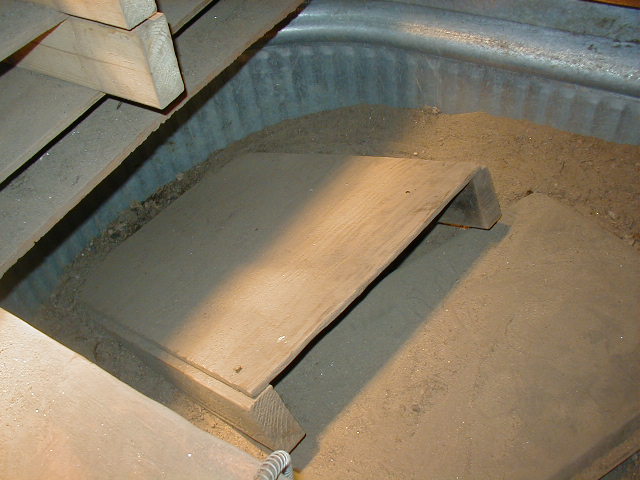
A plywood hide spot.
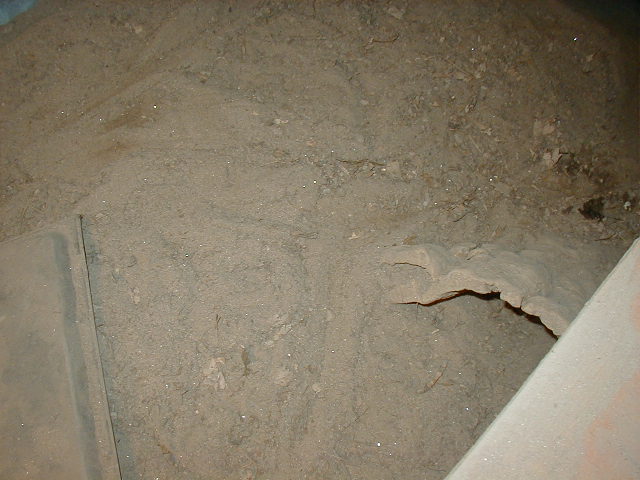
A cork round hide spot.
A hide spot is important for more than just security. Wild monitors use
burrows to cool off when it is too hot, to keep from getting too cold when
the outside temperature drops too low, and to help conserve moisture.
Monitors know that a burrow needs to have the proper combination of
temperatures and humidities, but us people just do not seem to appreciate
what really makes a good burrow. What seems like a fine burrow to us may
be uncomfortable or even unacceptable to a monitor. Thus, it is a good idea
to provide several hide spots, so the monitor can choose one that has the
right environment.
One idea is to take the plywood and spacer design described above, make a
whole bunch of them, and stack them on top of each other underneath the
heat lamp. The top hide spot, right under the heat, will be nice and
toasty. Lower hide spots are progressively cooler. It also lets the monitor
get closer to the heat lamps, which can be a good thing.
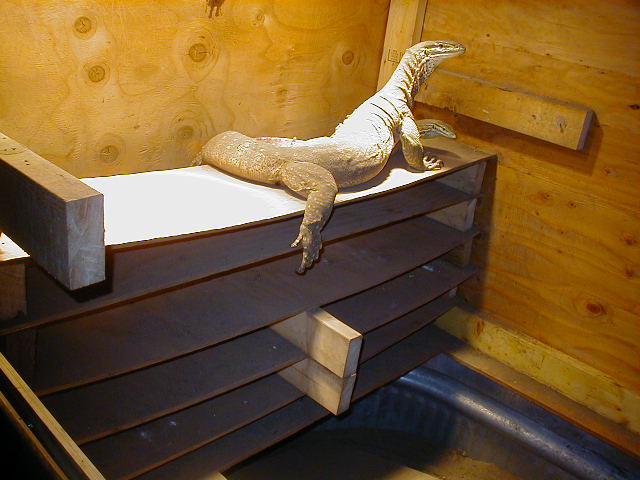
A plywood stack. This is narrower than the ideal stack, but Dash and Varanica seem to use the various levels to good effect.
This takes us to substrate. The best substrate for an argus monitor is dirt. Just plain dirt. Why? Argus monitors really like to dig. That's what they are good at, and they love to practice their trade. In particular, covering the entire cage with dirt lets the argus monitor digs its own burrow just where the conditions are best. A burrow in dirt is the best possible hiding spot for an argus, because not only does it provide security, but it allows the monitor to use the burrow for water conservation and thermoregulating like a monitor would naturally do in the wild.
The trick is, it has to be deep enough to make a good burrow in, 30 to 60 cm of dirt seems to work just fine. In addition, there are good dirts and bad dirts. Argus monitors prefer a sandy dirt, other monitor species like different kinds of dirt and some of them can be awfully particular about it. Some people are lucky enough that they can just go out in their back yards and dig up dirt for their monitors. When I tried this, the dirt quickly turned into a fine dust everywhere that it didn't get wet, and became a reeking sticky oozy paste everywhere it did get wet. If you can't get dirt from your backyard, you have two options: dig it up somewhere else and haul it back, or buy it. If you are going to haul it, you'll need at least a pickup truck bed's full of dirt for a typical argus enclosure. If you are going to buy it, you can mix together about 12 50 lb bags of playsand with 12 40 lb bags of topsoil for something that works reasonably well for an 8' x 4' enclosure, if you buy the right topsoil. Unfortunately, topsoil probably varies quite a bit from vendor to vendor and from region to region even with the same vendor. An alternative it so buy a truckload of dirt from a landscaping company.
The big problem with dirt is that it is heavy, you need a lot of it, and so you have to do a lot of hard labor to get it into your monitor enclosures. Other substrates can be used, but the difference a good dirt makes is so significant that I would not recommend anything else over the long term. For animals undergoing medical care or quarenteen, or for those in need of temporary housing, newspaper, care fresh, or cypress mulch or aspen chips can be used.
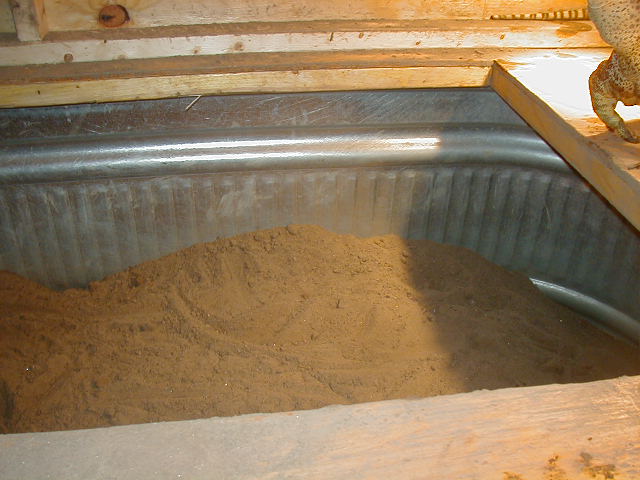
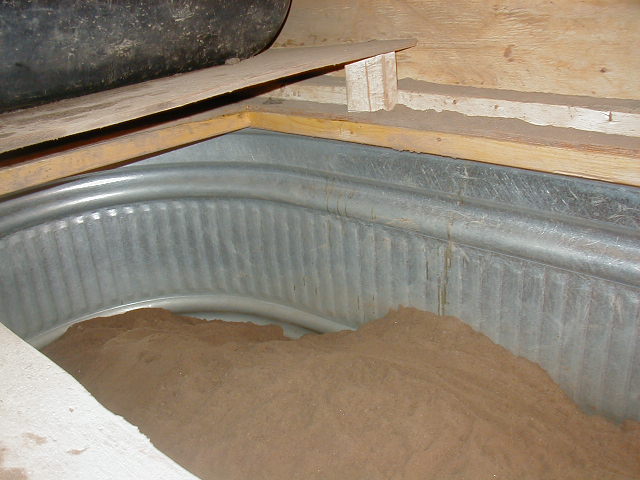
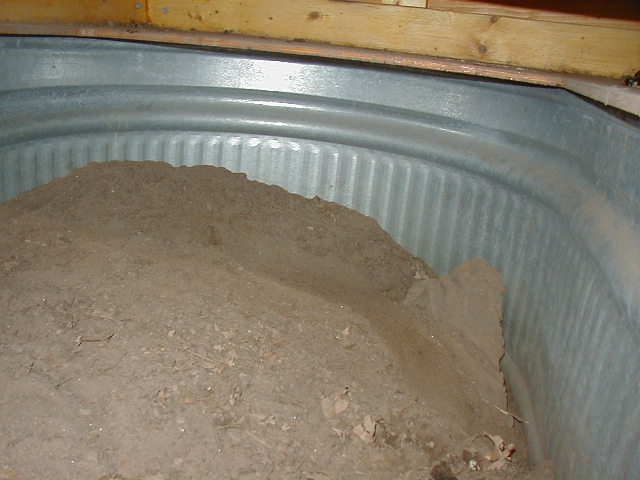
Dirt for burrowing.
I find that argus monitors in particular often like to dig at
their food. For example, even when you
present beetle larvae on hard ground, arguses will often dig and scratch
around to try to "dig up" their food. I believe this has a similar origin
to the food "washing" of racoons, or to food peeling by agoutis. In these
cases, the animal has an instinct to prepare or acquire its food by a set
of ritualized actions (foraging in the water under rocks with its hands in
the case of racoons, peeling hard shelled nuts for agoutis, or digging up
subterranian prey in the case of argus monitors). When these animals are
prevented from employing their instinctive methods of food acquisition,
they will employ them when not appropriate to the situation out of
something akin to frustration.
Another behavior which is an artifact of captivity is constant digging
or scratching at the sides of the enclosure. Sometimes this digging or
clawing is just an adjustment phase the lizard will go through before it
settles in, but if it is still digging and clawing at the sides after a
week or so, consider it a warning that its housing conditions are inadequate. there is something in its enclosure which is missing that the monitor instinctively knows it needs. Does it have enough space? Is there a large enough range of temperatures for the monitor to warm up to its preferred body temperature and to cool off when it needs to? It is too dry? Too humid? Is there a suitable hide spot?
I notice that my arguses, which are kept in large enclosures with a
complex environment, do not usually dig unless they
smell food, and although sometimes they will try and get out the window,
this behavior is fairly infrequent (at least once they adjust to their new
home). Be aware that gravid females will often dig, dig, dig. They are
trying to make a nest for their eggs, and will dig in every available corner
to try to make one. If you have your monitors on deep dirt that holds a burrow, she will naturally make a nest and lay her eggs in it. Otherwise, the best thing is to provide
a nest box for the female.
In addition to a hide spot and substrate, your monitor will need a water
dish. They
really appreciate the chance to soak, so make it big enough to submerge
the monitors entire body. A cat litter pan suffices for most monitors,
but big ones may need a concrete mixing pan or even a bathtub. Monitors
often like to relieve themselves in their water dish. This means that you
will need to change the water frequently, but also means that you do less
work keeping the rest of the cage clean. Argus monitors are so active that
they tend to track water all around their cage, making it into a soggy mess.
What I find helps is to put the water dish inside a somewhat larger dish to
catch a lot of the water that would otherwise be tracked onto the substrate
and floor. It doesn't solve everything, but it helps. If you find your argus monitor spending a lot of time in the water, chances are the cage is too dry. Once again, if it could dig a burrow in dirt, it would be able to regulate its humidity at the same time, and the problem would be solved. The next best thing would probably be to give your monitor a tight hide spot packed with peat moss or dirt or coconut pith planting mix or something that will hold moisture.
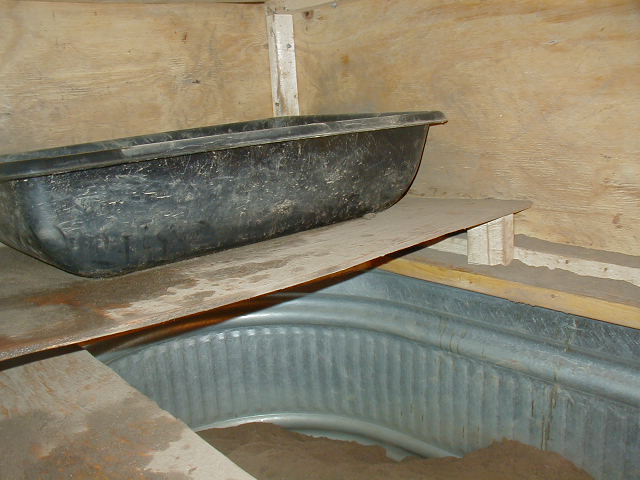
A concrete mixing trough used as a water dish.
Some monitors appreciate branches to climb on. Some could care less. If
you give them climbing branches, make sure they are very sturdy. Live plants
are pretty much right out. Argus monitors will climb the plants and break
off the branches, and will enthusiastically dig up the potting soil and
spead it all over their cage. If you really want to use live plants, expect
to replace them frequently.
As for temperature, keep in mind that the active temperature range
of any monitor is between 30 and 40 degrees Celcius, with a prefered temperature
of around 35 to 36 Celcius. Since monitors are cold blooded, they need
outside sources of heat to warm up, but they also need cooler places to shed
excess heat when necessary. I like to keep the ambient air temperature around
25 to 30 C except for a possible winter cooling period, when the ambient
temperature can drop to around 20 C. (Note that a winter cooling period
is not necessary, even for breeding purposes. Argus monitors can be kept at
high temperatures year round, and they will stay active, healthy, and the
females will cycle regularly.) The basking spot is kept significantly above
40 C. I like to keep a central area under the basking spot at least as
large as a monitor's body as hot as possible so long as it is not hot enough
to burn. This allows the monitor to warm up quickly when they need to.
When basking, they will almost always choose this hottest spot. A good
rule of thumb is that if you put your hand on the hottest part of the basking
spot and it is not hot enough to cause pain, it is not too hot. A range of
45 to 55 C is probably fine. Remember, though, that your lizard also has
to be able to cool off. It the lizard's internal temperature goes above
42 C, its brain will addle and it will die. The same thing happens to people,
too, except that people make more use of cooling by evaporation, monitors
only use evaporation to cool themselves when they are in thermal stress and
about ready to overheat. They far prefer to rest in the shade where it is cool.
At night, the basking lamps can be turned off and the lizard cooled. They
will warm up again in the morning.
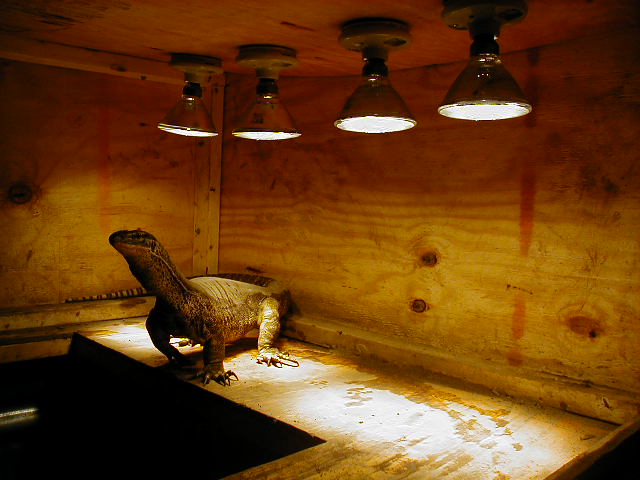
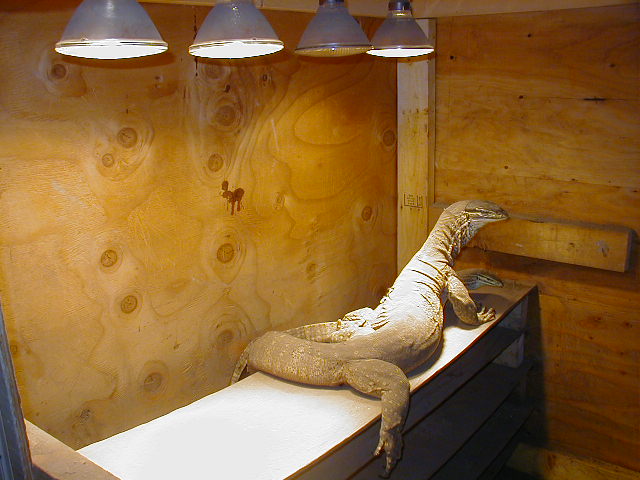
Racks of 4 90 Watt halogen floodlamps are used to create these basking spots.
Basking heat is best supplied by radiant heat. I use racks of 90 Watt halogen flood lamps in a line large enough to provide a more or less even swath of high temperature as long as the monitor's body. Incandescent bulbs provide less radiant heat for their wattage than halogens, both are equally good at raising the ambient heat, but halogens are better for basking spots.
Some people wonder about UV light. This does not seem to be neccessary for most monitors. Even rapidly growing juveniles and reproductive females do fine without UV as long as they are fed a good diet. I do often use the UV producing mercury vapor bulbs, but this is because these bulbs also more closely mimic the visible spectrum put out by the sun, so they really help to bring out the monitor's colors. A single 100 Watt mercury vapor fixture or self balasted bulb in combination with the halogen basking lamps provides a pleasing light for viewing your lizard. A mercury vapor fixture is cheaper in the long run than a self balasted mercury vapor bulb, especially since the self balasted bulbs often burn out after a month or two in spite of their advertizing that they last a whole year at least. The newer bulbs might do better, but when I bought eight self balasted bulbs in 2000, most had burnt out within three months and none lasted six months.
Arguses, like most monitors, can and should be fed a wide variety of food
items. Crickets, mealworms, superworms, giant tropical cockroaches,
earthworms, mice, rats, chicks, and hard boiled eggs are all eagerly
devoured when available. It is a good idea to feed whole vertabrates
regularly, because whole vertabrates have all the necessary vitamins,
minerals, and other foodstuffs needed to stay healthy. On the other hand,
if feeding them rodents, it is a good idea to kill the rodents first.
Although an argus monitor can kill a mouse nearly every time without getting
hurt, sometimes the mouse gets lucky. Rodents have long, chisel-like
incisors that make deep, easily infected punctures. Not only that, but
frozen mice are usually cheaper, and are always less stinky, easier to
catch, don't need to be fed, won't bite you, and in general a lot less
trouble. If your pet store carries frozen rodents, its worth your
while to get these over live ones.

Giant tropical roaches.
One thing that I have noted with argus monitors is that it is difficult to
feed them too much. Unlike savannas, they do not seem to get obese. All
excess food goes into growth (for juveniles), making eggs (for females),
or just their generally high activity levels (for all animals). In
particular, females will regularly develop and lay eggs. If well fed and kept unde rthe appropriate conditions, a female argus can lay every six to eight weeks, year round. They do this whther or not a male is around, but obviously, without a male the eggs will not be fertile. A gravid female begins to look fat or, more
accurately, bloated. A week or so before laying eggs, she will go off
feed and begin digging around everywhere. If you are not using a deep dirt substrate, this is a signal that you need
a nest box. I have made mine out of 10 gallon rubbermaid containers, with the
lid firmly affixed but a hole drilled out of the side large enough to
allow a gravid female to get in and out (use one of those attachments for
drilling out the hole in doors where doorknobs go). This container is
then filled with damp coconut pith bedding. The female will begin digging in this dark, damp hole and
probably lay her eggs in there several days later. Using a nest box can be fairly stressful on the female if conditions are not right, however, which is another reason to use dirt - it is a lot easier on the female at egglaying time. She will be very
skinny when she finishes laying and will probably be ravenous. Of course,
they are always ravenous, so you might not notice much difference from her
normal behavior, but it would be a good idea to feed her heavily for a
while to get her body weight back up. That means, of course, that she
will soon start to develop eggs again. By the way, argus monitors are
easy to breed. Just introduce a male and female and they
produce fertile eggs regularly. My pairs of arguses breed regularly
and produce frequent clutches of eggs.
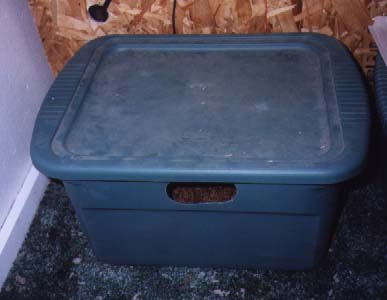
View of a nest box.
To incubate the eggs, place them in a damp medium such as vermiculite or pearlite. Damp does not mean wet. I've lost many clutches to an overly moist nesting medium before I figured out what I was doing wrong. The nesting medium should be just barely perceptably damp to a probing finger. Bone dry is as undesirable as obviously damp or soggy. Check the eggs frequently to keep the moisture level right.
A few notes of caution. All my females hate each other. They try to rip
each other to shreds every chance they get. This behavior may be
alleviated by raising the females together from the time they are very
young.
Males and females will often get
along just fine, depending on their individual personalities. Adult males occasionaly get along, but more often it turns into a big dominance contest or just a bloodbath as they tear into each other with teeth and claws. Also, it is a good idea not to feed argus
monitors together. They are such agressive feeders that they will often
injure each other in a sort of shark-like feeding frenzy.

Chris snags a mouse
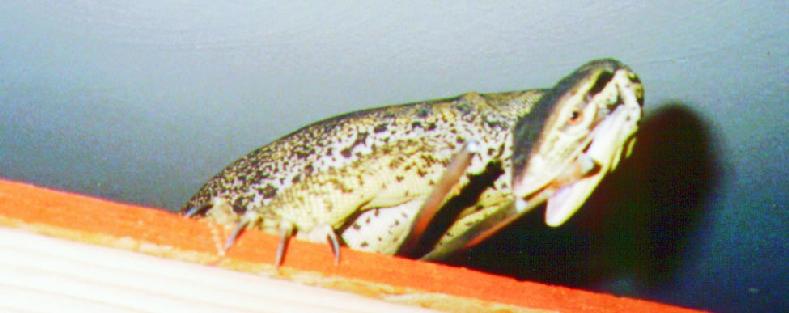
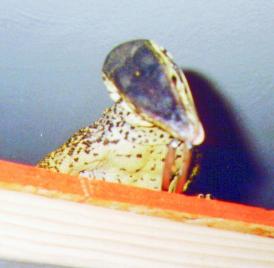
Monitors are very quick learners. Chris very quickly found out
that the hemostats mean food, and even which end holds the food. She is
still not all that clear on when the heomstats have food in them, though.
For obvious reasons, I do not feed my arguses by hand. I offer them food
with a long (about 1 meter) pair of hemostats, or I give them beetle grubs
or giant cockroaches in a large conatiner. I've been bitten a few times by
adult arguses and I've found that their bites are much more serious than
those of much larger Niles and savannas. Although their jaws do not have
the crushing power of the African monitors, their teeth are designed for
slicing flesh; sharp, teardrop shaped in cross section, and slightly
recurved toward the back to make an efficient cutting blade. The African
monitors typically have sharp conical teeth for piercing and holding or
blunt crushing teeth for cracking shells. The sharp cutting teeth of
the arguses
combined with the very well muscled necks and torsos of the monitor lizard
family give a very nasty wound when they can bite and thrash. One one
occasion, an argus monitor drove one of its teeth through the
first joint
on my left index finger. This caused the joint to swell painfully for
several weeks and prevented full range of motion in this finger for
many months. On another occasion, my right index finger was sliced
open. The wound was deep, covered half the
width of my finger, and bled
freely. My finger swelled up for several days and the wound did not close
for about a week. Noteably, in both
of these cases, the bite was a quick grab and release. In neither case
did the monitor try to hold on and "go for the kill" by thrashing about.
I've seen mice ripped nearly in half by juvenile argus monitors using this
technique, I'd hate to see what an adult could do to a person. I'm not
trying to scare you away here, but you need to realize what these animals
are capable of. Not only that, but they are fundamentally wild animals,
even if they have lost their fear of humans, and incredibly athletic wild
animals at that. Your pet argus will probably have faster reactions than
you do. It is important to take care when the argus is likely to be
nervous or if it is in feeding frenzy mode. Most of the time, a nervous
argus is just hiss and bluff, but if you suddenly lunge or grab it, it may
bite. They may also bite if your fingers smell like their normal food.
I have a pair of heavy leather welders gloves, padded and reinforced with
kevlar, for situations where I feel that my pets may try to take a chomp
out of me. These can stop the bite of a small monitor and blunt and absorb
the bite of a large argus enough th prevent serious wounds, although on
a couple memorable occasions, one of my big male arguses was able to give me a
scratches and shallow cuts with
his teeth through the heavy leather gloves while in the process of
shredding the gloves.
A female argus is likely to get about the size of a large male ferret,
say, around 3 kilos. My male arguses are both larger than a large
tomcat,
10 kilos each the last time I weighed them. I have heard
that one of the subspecies of the Australian argus monitor gets even
larger, large enough to rival the lacies and perenties in size. I'd love
to get one of those! Nevertheless, the New Guinea arguses on the American
market today are certainly very spectacular creatures.
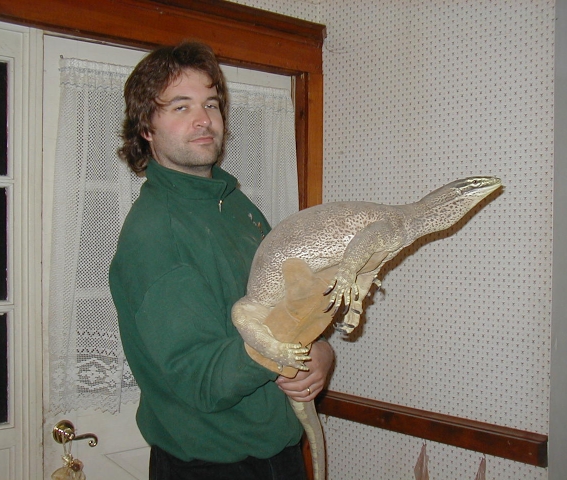
A photo showing the size of Dash, an adult male
argus monitor, compared to a human (me). To put things in perspective, I'm
193 cm high, about 90 kilograms.
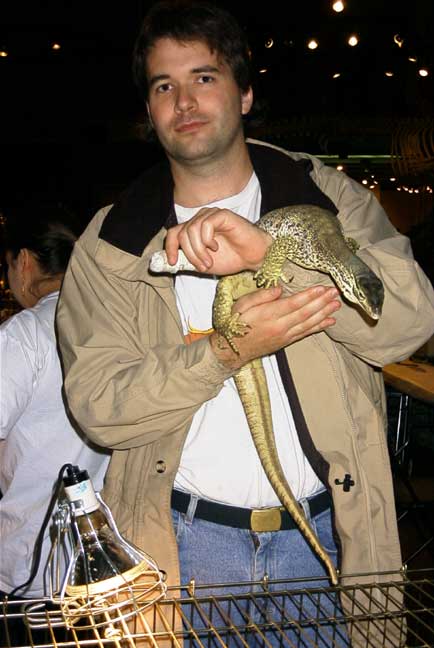
Photo courtesy of Mark Silver
A photo showing the size of Chris, a medium sized female
argus monitor, compared to a human. No, the bandaged thumb is not
from a monitor bite. This photo was taken while displaying Chris at
the Pacific Northwest Herpetological Society's annual show at the Pacific
Science Center at the Seattle Center in Seattle, Washington.
monitor
resources
back to
argus monitor main page





